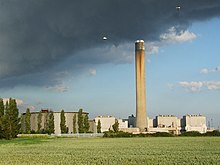Grain Power Station
| Grain Power Station | |
|---|---|
 |
|
| Country | England |
| Location |
Isle of Grain Kent |
| Coordinates | 51°26′43″N 0°42′54″E / 51.445181°N 0.715028°ECoordinates: 51°26′43″N 0°42′54″E / 51.445181°N 0.715028°E |
| Commission date | 1979 |
| Decommission date | 2012 |
| Operator(s) | Uniper |
| Thermal power station | |
| Primary fuel | Oil-fired |
| Tertiary fuel | Natural gas |
| Cogeneration? | Yes |
| Combined cycle? | Yes |
| Power generation | |
| Units operational | 5 (2 oil, 3 gas) |
| Make and model | Alstom (CCGT) |
| Nameplate capacity | 1,320 MW (1,770,000 hp) (oil) and 1,275 MW (1,710,000 hp) (gas) |
|
Website www |
|
| grid reference TQ886753 | |
Grain Power Station is a CCGT power station and former oil-fired power station in Kent, England, with operational capacity of 1,275 megawatts (1,710,000 hp) owned by Uniper (formerly E.ON UK).
Grain was built on a 250-acre (100 ha) site for the nationalised Central Electricity Generating Board. It was built by several contractors including John Laing Construction (Civils), the Cleveland Bridge Company (Steel Frame & Cladding), N. G. Bailey (Electrical), Babcock & Wilcox (Boilers) and GEC Turbine Generators Ltd (steam turbines) beginning before 1975. It opened in 1979. It was located on the Isle of Grain, where the River Medway flows into the Thames Estuary. The station had the second tallest chimney in the UK, at 244 metres (801 ft), visible from a wide area of North Kent and parts of South Essex; Drax Power Station has the tallest chimney, at 259 metres or 850 feet. This chimney was demolished at 11am, on September 7th, 2016. Grain adjoins the site of the BP Kent oil refinery, which closed in 1982. The station burned oil to drive, via steam turbines, two 690 megawatts (930,000 hp) (gross power output – but 30 megawatts (40,000 hp) was used on-site, leaving 660 megawatts (890,000 hp) for export to the Grid) alternators. The station was capable of generating enough electricity to supply approximately 2% of Britain's peak electricity needs.
The station was originally designed to have a total capacity of 3,300 megawatts (4,400,000 hp) from five sets of boiler/turbine combinations. The two remaining oil-fired generating units were mothballed by Powergen in 2002 and 2003, but almost immediately the company began to consider reopening the plant as electricity prices increased rapidly. It was operated by E.ON UK who also operated the nearby Kingsnorth coal-fired station, now also decommissioned.
...
Wikipedia

